
An integral part of human life, music is used to express both joy and despair. It is also a way to vent frustration and opinion against the social and political disorder. Guitar, the most popular of all musical instruments has been instrumental in bringing about a change in the society. Introduced in the 12th century as a chordophone, the Guitar saw several variations to finally emerge as the present day popular instrument. The sound of the Guitar accompanied by the power of voice and words has been a dominant element of music especially the blues and rock. Belonging to the string family of musical instruments, the Guitar has been a harbinger of change and has slowly evolved into the style and spirit of new music. A person who plays the Guitar is called a Guitarist. Let us learn more about this musical instrument.
Presence of the Guitar can be traced back to the Renaissance period (1300–1700) when plucked stringed instruments such as the vihuela, cittern, mandore and lute were found according to the literature records. The vihuela was similar to the present day Guitar and had six or seven strings. The 15th century saw the creation of an instrument which can be recognized as modern day Guitar. This instrument overtook the vihuela in popularity. From the middle of the 16th century till the 18th century, the baroque Guitar enjoyed popularity in Europe. Several changes and modifications gradually saw the emergence of the present day Guitar. The name Guitar may have been derived from the German word ‘gitarre’ or French word ‘guitare’. The instrument reached America in the 19th century and became popular. Today, the Guitar is available in many forms such as classic, acoustic, semi–acoustic and Electric Guitar.
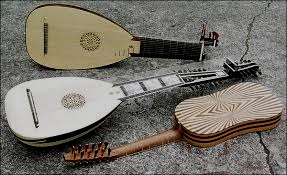
A Guitar is a stringed instrument as well as a chordophone. Sound in the Guitar is produced when the strings that run along the body of the instrument are plucked. The strings are plucked (either by a hand or a cue) and the frets placed beneath the strings are fingered at the same time. The sound that is produced is amplified in the resonating body of the Guitar. A Guitar may be 4–stringed, 6–stringed or 12–stringed.

Components of a Guitar include headstock, nut, frets, battery, sound hole, bridge, body, fret board, neck tuners and saddle. There may be additional components depending upon the type of Guitar, whether electric or acoustic or classic. Electric Guitar may have pickups.
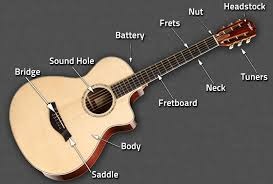
A Guitar is mostly made of wood and the Brazilian rosewood is the most preferred. As an alternate, the East Indian wood, mahogany and maple are used. Firstly, the wood is selected and cut into two sheets and is shaped accordingly. The sound holes, concentric circles around the holes and various other slots for the fittings are carved out with precision. Braces are glued on the inside of the top part in the widely used X–pattern which controls the vibrations. The back acts as a reflector of sound waves and is also braced left to right. For making of sides, pieces of wood are softened and are placed into moulds, which are shaped according to the curves of the Guitar. The two sides are joined to the basswood that is glued to the inside walls of the two sheets. The end blocks of wood are used to join the top, neck and back. Once the sides are joined and end blocks are fitted in place, the top and back are glued to the sides. The neck is made from a single piece of hard wood and a reinforcing rod is inserted through the length of the neck. The fingerboard is set in place and the fret slots are cut to precision on the fingerboard and steel–wired frets are put in place and the neck is attached to the body. A bridge is placed near the bottom of the Guitar body and a saddle is fitted for the strings. Next, the most important tuning machine is fitted to the back of the Guitar head and the pegs, gears and keys are placed in metal castings. Finally, the Guitar is strung.
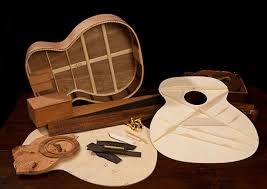
A Guitar is the most popular of all music instruments and cuts across the barriers of age, region and gender. An important part of many ensembles such as jazz, fusion jazz, reggae, rock, pop and country music, Guitar was initially played for blues and rock. Blues was the rhetoric kind of music played by the Afro–American people as a sign of protest against social discrimination. As societies transformed, the Guitar became the symbol of joyful as well as soulful music. Today, Guitar is an essential part of all musical ensembles and is highly popularized by rock, jazz and pop artistes in orchestras, symphonies, sonatas, jazz, rock and roll and pop music.
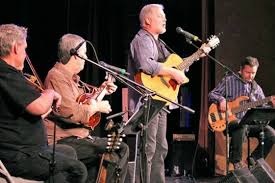
Guitars can be classified as:
- Classical Guitar or Spanish Guitar: It has nylon strings and is plucked by fingers and played solo in classical music.
- Acoustic Guitar: It does not need any electronic device for sound amplification and sends sound vibrations from the strings directly into the air and has a hollow body.
- Semi–acoustic Guitar: It is a semi–hollow body electric Guitar with a sound box and pickups.
- Electric Guitar: It is fitted with built–in pickups, a sound amplifier and a microphone.
- Electro–acoustic Guitar: This is an acoustic Guitar fitted with magnetic pickups and microphone.
- 12–string Guitar: It is a Guitar which has 12 strings attached to a wide neck. It is made as acoustic and electric both and sound made by it is full more resonating.
- Archtop: This can be a semi–acoustic or acoustic Guitar and has an arch–shaped body. Archtop Guitar is very popular with jazz players.
- Steel Guitar: It is a type of acoustic Guitar with a metal, usually a steel resonator. It is played with the help of a slide and sounds a variable tone.
- Bass Guitar: This is an electric Guitar played by the thumb or finger or is plucked by a plectrum and has a distinct sound.
- Resonator Guitar: They are also known as Dobro or Resonator ukulele and are fitted with more than one aluminium resonator.
- Double–neck Guitars: They have one body with two necks. One neck has 6–strings whereas other neck is fitted with 12–strings. They are mostly used to play variations in music.
Most of these variations depend on the number of strings, resonator and pickups.
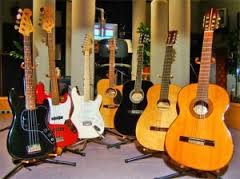
Names of some of the notable guitarists include Baden Powell de Aquino, Jimi Hendrix, Tom Morello, B.B King, David Gilmour, Stevie Ray Vaughan, Jimmy Page, John Mayer and Jack White. Pop artistes such as the legendary Elvis Presley and John Lennon of Beatles are still popular for their compositions played with the Guitar. Modern Guitarists are Bryan Adams, Eric Clapton, Benji Madden, Chuck Berry, Nelly Furtado and Bruce Springsteen.
Beginners can learn to play the Guitar on the beginner’s Guitar. Teachers and established players can be sought for guidance. Beginners may learn to play in weeks, months, a year or more than a year. There are music schools in UK, USA and Germany, the notable being the Yale School of Music and Berkeley School of Music in the US. The learning process involves:
- Basics, which includes the identification of different parts, holding the Guitar correctly and tuning it.
- Practice fretting of the strings and start strumming with the help of a pick or plectrum.
- Start playing the chords with the plectrum and try getting a clear sound.
- Strum and learn to play the bar chord with the index finger.
- Practice by playing the tune of a popular song.


